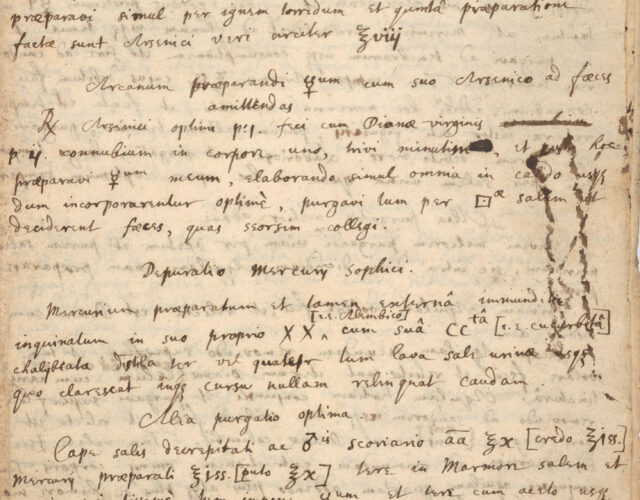Eirenaeus Philalethes was at the height of his fame in the second half of the 17th century. His chemical writings had influenced Robert Boyle and would later guide the alchemical work of Isaac Newton. Even into the early 18th century these writings influenced such foundational figures in chemistry as Georg Stahl. “Philalethes was a name to conjure with,” says William Newman, a historian of alchemy and early chemistry at Indiana University. Many considered Philalethes an adept, one of those sufficiently learned in alchemy to have created the philosophers’ stone. But almost as unusual as his transmutational skills were his origins: Philalethes was American.
Neither Newton nor Boyle ever met the reclusive Philalethes. Instead, his friend and fellow American George Starkey shared Philalethes’s writings and doings with the world. Starkey was also a chemical practitioner, though his reputation never grew as large as Philalethes’s. By the standards of the colonies Starkey was well educated, receiving a degree in 1646 from fledgling Harvard College, the leading center of alchemy in America. Starkey moved to England in 1650, in part to make his name and in part because good laboratory equipment was hard to find in the colonies. He quickly came to the notice of those with chemical interests and was even Boyle’s alchemical teacher for a time.
Like many other alchemists, Starkey and Philalethes were on a quest to create the alkahest—the solvent that would break down matter to its most basic constituents from which new substances could be formed—and of course, the philosophers’ stone, which could transmute base metal into gold. The concept of gold making—or, more officially, transmutational alchemy—had been around since Roman times and remained a part of chemistry until the 1720s, when alchemists found something even more valuable—drugs.
The possibility of transmutation had always been used by alchemists to hook patrons, says Newman. “They didn’t have the National Science Foundation back then. They would go to people like Leopold I, the Holy Roman Emperor, and say, ‘I can give you gold from which you can make coinage.’ Once these alchemists figured out a way to make money from pharmaceuticals, many of them opted for it, and gold making went by the wayside.”
Back in the 1600s Philalethes had chemical secrets he shared only with those he considered deserving, fellow alchemists who eschewed material gain in pursuit of greater truths. To this end Philalethes would code his meaning in allusive and metaphorical language that was impenetrable to the ignorant and unworthy, including gold-hungry princes and kings—men known to hang alchemists who didn’t deliver riches.
Starkey certainly qualified as one of those worthy of Philalethes’s knowledge. While Starkey had an interest in making gold, his work also led him to pursue the practical products of chemistry and to doctoring. He turned his metallurgical and chemical skills to refining ores and to making his own drugs, dyes, and perfumes. Starkey’s medical practice was moderately successful, but the financial unpredictability of such a profession led him to debtors’ prison for a time.
While Starkey rode life’s vicissitudes, his friend rocketed to fame. By acting as Philalethes’s go-between, sharing his friend’s work while also publishing his own, Starkey gathered some recognition for himself. But Starkey’s share of Philalethes’s fame later evaporated. Starkey, who died of the plague in London in 1665 while treating its victims, was left with a posthumous reputation as a plagiarizer of the great Philalethes.
Starkey had an even greater secret than Philalethes, one that remained hidden until Newman discovered it in the 1990s. Eirenaeus Philalethes—who produced some of the most significant writings on alchemy in the 17th century and who influenced Boyle and Newton—was Starkey’s alter ego. A handful of scholars in the 20th century suspected the two were one and the same, but no solid evidence existed. “I was able to nail the coffin shut,” says Newman, who compared letters Starkey wrote to Boyle with Philalethes’s later writings on the same subject. Unlike Philalethes, Starkey wrote in comprehensible 17th-century English, but the content was often the same.
Both Starkey and Philalethes wrote about the properties of matter as well as its structure, and these ideas influenced Newton’s thinking and practice, including perhaps his thinking about light and how white light could be broken down and recombined in ways similar to matter. Newton, whose own alchemical interests weren’t widely rediscovered until the 20th century, left a million words of alchemical material written in his own hand. CHF recently bought one of those manuscripts, which includes a copy of Starkey’s instructions for making and using philosophic mercury (a component needed to create the philosophers’ stone) as well as some of Newton’s own notes. Newton, of course, never knew he copied Starkey’s work.
In Gehennical Fire, Newman’s book on Starkey, the American doctor and alchemist finally receives his due. “It is highly likely,” writes Newman, “that Starkey’s output under the guise of Philalethes makes him the most widely read American scientist before Benjamin Franklin.”




